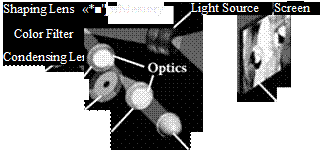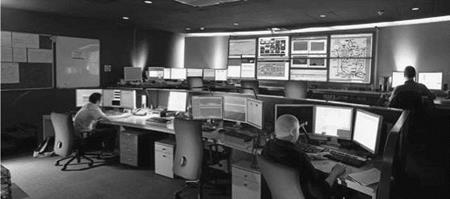 |
The designation ‘thin film transistor’ (TFT) already suggests that the transistors are responsible for the screen layout. They control the action of liquid crystals, which
FIGuRE 4.31 A single-chip DLP projection system. (Copyright © Texas Instruments.) (See colour insert.)
are used in an LCD. In comparison to the usual large surface flickering of conventional tube monitors, TFT monitors supply flicker-free, pen-sharp image information and therefore relieve the viewer of eye strain. Thus, even several monitors can be supervised during a longer period of time, fatigue-free, and in accordance with the strict ergonomic requirements. Additionally, TFT monitors emit almost no radiation and their images cannot be distorted by magnetic fields. Flat screens are very well suited for installation in furniture and/or rack systems because of their low heat development. However, after continuous operation, so-called ghost – images can appear very often, which are similar to the burn-in effect on plasma screens mentioned above. These ghost-images can be revoked by switching the screen off for 24 hours (Figure 4.32).
These monitors can be used in a number of applications including flight information displays on airports, trade shows, and video surveillance. They can also be used in a number of office applications. The technology has a number of advantages. For example, the product needs less space to set up and operate. The price is attractive for the level of technology. In terms of the quality of viewing, the product offers high brightness with high contrast. The disadvantages are several. In certain situations the memory effect with static images can be lost. The image format is normally 16:9 whereas the usual format in industrial applications is 4:3 or 5:4. There can be large gaps in between the single displays when these are put together. The present technology has limits in maximum diagonals.
|
FIGURE 4.32 Control room with an LCD wall, graphics controller, and wall manage ment software. (© eyevis-guillaume czerw. With permission.) (See colour insert.) |
|
FIGURE 4.33 CCTV surveillance control room for a city centre. (© eyevis-guillaume czerw. With permission.) (See colour insert.) |





